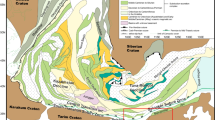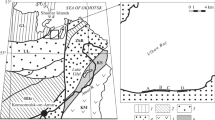Abstract
Paleomagnetic investigations have been carried out on poorly determined radiometric age controls of Bhander sandstones within the vicinity of Bhopal Inlier of the Upper Vindhyan Supergroup. Available ages assigned to the Upper Vindhyan sequence range from Cambrian to the Mesoproterozoic and are derived from a variety of sources and methods. Paleomagnetic data generated from the Bhander Group of Bhopal Inlier yielded a mean declination of 357° and mean inclination of 58° (k=17.69, α95 = 16.38) with a Virtual Geomagnetic Pole (VGP) at 74° N, 69.0° E. This pole position is falling close to the Malani Igneous Suite (MIS) mean palaeomagnetic pole of 67.8° N and 72.5° E (A95=8.8°) by Gregory et al. (2009). The results obtained from this study and previous work on the 1073 Ma Majhgawan kimberlite, as well as detrital zircon geochronology of the Upper Bhander sandstone suggest that the Upper Vindhyan sequence may be older than is commonly thought earlier.
Similar content being viewed by others
References
Ahmad, F. (1958) Palaeogeography of Central India in the Vindhyan period. Rec. Geol. Surv. India, v.87,pt.2, pp.513–548.
Athavale, R. N., Radhakrishnamurty, C. and Sahasrabudhe, P. W. (1963) Palaeomagnetism of some Indian rocks. Geophys. Jour. Royal Astron. Soc., v.7, pp.304–307.
Athavale, R.N., Hansraj Asha and Verma, R.K. (1972) Palaeomagnetism and Age of Bhander and Rewa Sandstones from India. Geophys. Jour. Royal Astron. Soc., v.28, pp.499–509.
Bose, P.K., Sarkar, S., Chakrabarty, S. and Banerjee, S. (2001) Overview of the Meso- to Neoproterozoic evolution of the Vindhyan Basin, central India. Sed. Geol., v.141, pp.395–419.
Chaudhuri, A.K., Mukhopadhyay, J., Patranabis-Deb, S. and Chanda, S.K. (1999) The Neoproterozoic cratonic successions of peninsular India. Gondwana Res., v.2, pp.213–225.
Condon, D., Zhu, M.Y., Bowring, S., Wang, W., Wang, A.H. and Jin, Y.G. (2005) U-Pb ages from the Neoproterozoic Doushantua Formation, China. Science, v.308, pp.95–98.
Crawford, A.R. and Compston, W. (1970) The age of Vindhyan system of peninsular India. Quart. Jour. Geol. Soc. London, v.175, pp.351–370.
Dhar, S., Frei, R., Kramer, J.N.D., Nagles, T.F. and Kochhar, N. (1996) Sr, Pb and Nd isotope studies and their bearing on the petrogenesis of Jalor and Siwana complexes, Rajasthan, India. Jour. Geol. Soc. India, v.48, pp.151–160.
De, C. (2003) Possible organisms similar to Ediacaran forms of the Bhander Group, Vindhyan Super Group, Late Neoproterozoic of India. Jour. Asian Earth Sci., v.21, pp.387–395.
De, C. (2006) Ediacaran fossil assemblage in the Upper Vindhyans of Central India and its significance. Jour. Asian Earth Sci., v.27, pp.660–683.
Gansser, A. (1964) Geology of the Himalayas. Interscience. New York, N.Y., 289p.
Gregory, L.C., Meert, J.G., Pradhan, V., Pandit, M.K., Tamrat, E. and Malone, S.J. (2006) A paleomagnetic and geochronologic study of the Majhgawan Kimberlite, India: Implications for the age of the Vindhyan Supergroup. Precambrian Res., v.149, pp.65–75.
Gregory, L.C., Meert, J.G., Bingen, B.A., Pandit, M.K. and Torsvik, T.H. (2009) Paleomagnetism and geochronology of the Malani igneous suite, Northwest India: implications for the configuration of Rodinia and the assembly of Gondwana. Precambrian Res., v.170, pp.13–26.
Kendall, B., Creaser, R.A. and Selby, D. (2006) Re-Os geochronology of postglacial black shales in Australia: Constraints on the timing of the “Sturtian” glaciation. Geology, v.34, pp.729–732.
Klootwijk, C.T. (1973) Palaeomagnetism of upper Bhander sandstones from central India and implications for a tentative Cambrian gondwanaland reconstruction. Tectonophysics, v.18, pp.123–145.
Klootwijk, C.T. (1975) A note on the Palaeomagnetism of the Late Precambrian Malani Rhyolites near Jodhpur, India. Jour. Geophys., v.41, pp.189–200.
Klootwijk, C.T., Nazirullah, R. and De Jong, K.A. (1986) Paleomagnetic constraints on formation of the Mianwali reentrant, Trans-Indus and Western Salt Range, Pakistan. Earth Planet. Sci. Lett., v.80, pp.394–414.
Kochhar, N. (1996) 750 Ma super continent: evidence from the Indian shield, In: Special Symp. F-9. The break-up accretion of the Asia continent: 30th IGC, Beijing, China. 255p.
Kochhar, N. (2001a) Anorogenic magmatism, mantle plume and assembly of the Late Proterozoic Malani supercontinent, NW Indian shield. In: International Symp. Assembly and breakup of Rodinia and Gondwana, and Growth of Asia: GRG/GIGE Misc. Publ. No.12, pp.22–27.
Kochhar, N. (2001b) Signatures and significance of the Pan-African thermo-tectonic event in the Indian subcontinent: Bull. Ind. Geol. Assoc., v.34, pp.36–42.
Kochhar, N. (2007) Was Yangtze Craton South China attached to the Trans-Aravalli block of the NW Indian shield during Late Proterozoic? Curr. Sci., v.92, pp.295–297.
Kochhar, N. (2008) A-Type Malani magmatism: Signatures of the Pan-African eent in the NW Indian shield and assembly of the Late Proterozoic Malani Supercontinent: Geol. Surv. India Spec. Pub. No. 91.
Krishnan, M.S. (1968) Geology of India and Burma. Higginbothams, Madras, 5th ed., 289p.
Malone, S.J., Meert, J.G., Banerjee, D.M., Pandit, M.K., Tamrat, E. Kamenov, G.D., Pradhan, V.R. and Sohl, L.E. (2008) Paleomagnetism and Detrital Zircon Geochronology of the Upper Vindhyan Sequence, Son Valley and Rajasthan, India: A ca. 1000Ma Closure age for the Purana Basins? Precambrian Research, v.164, pp.137–159.
Mazumdar, R., Bose, P.K. and Sarkar, S. (2000) A commentary on the tectanosedimentary record of pre-2.0 Ga continental growth in India vis-a-vis possible pre-Gondwana Afro Indian supercontinent. J. Afr. Earth Sci., v.30, pp.201–217.
Mcelhinny, M.W. (1968) Notes on progress in geophysics. Palaeomagnetic directions and pole positions. Geopys. Jour., v.15, pp.409–430.
Mcelhinny, M.W., Cowley, J.A. and Edwards, D.J. (1978). Palaeomagnetism of some rocks from peninsular India and Kashmir. Tectonophysics, v.50, pp.41–54.
Meert, J.G. (2001) Growing Gondwana and rethinking Rodinia: a paleomagnetic perspective. Gondwana Res., v.4, pp.279–288.
Meert, J.G. (2003) A synopsis of events related to the assembly of eastern Gondwana. Tectonophysics, v.362, pp.1–40.
Meert, J.G. and Powell, C.MCA. (2001) Assembly and Breakup of Rodinia. Precambrian Res., v.110, pp.1–8.
Meert, J.G., Van Der Voo, R. and Ayub, S. (1995). Paleomagnetic investigation of the Gagwe lavas and Mbozi complex, Tanzania and the assembly of Gondwana. Precam. Res., v.74, pp.225–244.
Meert, J.G. and Van Der Voo, R. (1996) Paleomagnetic and 40Ar/39Ar study of the Sinyai dolerite, Kenya: implications for Gondwana assembly. Jour. Geol., v.104, pp.131–142.
Mitra, N.D. (1996) Some problems of Vindhyan geology. Mem. Geol. Soc. India, no.36, pp.137–155.
Patranabis-Deb, S., Bickford, M.E., Hill, B., Chaudhuri, A.K. and Basu, A. (2007) SHRIMP ages of zircon in the uppermost tuff in Chattisgarh Basin in central India require up to 500 Ma adjustment in Indian Proterozoic stratigraphy. Jour. Geol., v.115, pp.407–416.
Powell, C. and Pisarevsky, S.A. (2002) Late Neoproterozoic assembly of east Gondwana. Geology, v.3, pp.3–6.
Raghav, K.S., De, C. and Jain, R.L. (2005) The first record of Vendian Medusoids and trace fossil-bearing algal matgrounds from the basal part of the Marwar SuperGroup of Rajasthan, India. Indian Minerals, v.59, pp.22–30.
Rasmussen, B., Bose, P.K., Sakar, S., Banerjee, S., Fletcher, I.R. and Mcnaughton, N.J. (2002a). 1.6Ga U-Pb zircon age for the Chorhat Sandstone, Lower Vindhyan, India: possible implications for the early evolution of animals. Geology, v.20, pp.103–106.
Ray, J.S., Martin, M.W., Veizer, J. and Bowring, S.A. (2002) U-Pb Zircon dating and Sr isotope systematic of the Vindhyan Supergroup, India. Geology, v.30, pp.131–134.
Ray, J.S., Veizer, J. and Davis, W.J. (2003) C, O, Sr and Pb isotope systematics of carbonate sequences of the Vindhyan SuperGroup, India: Age, diagenesis, correlations, and implications for global events. Precambrian Res., v.121, pp.103–140.
Sahasrabudhe, P.W. and Mishra, D.C. (1966) Palaeomagnetism of Vindhyan rocks of India. Nat. Geophys. Res, Inst., Hyderabad, Bull., no.4, pp.49–55.
Srivastava, A.P. and Rajagopalan, G. (1988) F-T Ages of the Vindhyan Glauconitic sandstone beds exposed around the Rawatbhata area, Rajasthan. Jour. Geol. Soc. India, v.32, pp.527–529.
Torsvik, T.H., Carter, L.M., Ashwal, L.D., Bhushan, S.K., Pandit, M.K. and Jamtveit, B. (2001a) Rodinia refined or obscured: palaeomagnetism of the Malani igneous suite (NW India), Precambrian Res., v.108, pp.319–333.
Torsvik, T.H., Ashwal, L.D., Tucker, R.D. and Eide, E.A. (2001b) Neoproterozoic geochronology and palaeogeography of the Seychelles microcontinent: the India link. Precambrian Res., v.110, pp.47–59.
Tugarinov, A.I., Shanin, L.R., Kazakov, G.A. and Arakelyants, M.N. (1965) On the Glauconite ages of the Vindhyan System (India). Geokhimiya [Akad. Nauk S.S.S.R.), v.6, pp.652–660.
Venkatachala, B.S., Mukund, S. and Shukla, M. (1996) Age and Life of the Vindhyans — Facts and Conjectures. Mem. Geol. Soc. India, no..36, pp.137–155.
Vinogradov, A.P., Tugarinov, A.I., Zhikov, C.I., Stanikova, N.I., Bibikova, E.V. and Khorre, K. (1964) Geochronology of the Indian Precambrian. Report of the 22nd International Congress, New Dehli, v.10, pp.553–567.
Author information
Authors and Affiliations
Corresponding author
Rights and permissions
About this article
Cite this article
Venkateshwarlu, M., Mallikarjuna Rao, J. Paleomagnetism of Bhander sediments from Bhopal Inlier, Vindhyan Supergroup. J Geol Soc India 81, 330–336 (2013). https://doi.org/10.1007/s12594-013-0043-5
Received:
Accepted:
Published:
Issue Date:
DOI: https://doi.org/10.1007/s12594-013-0043-5




